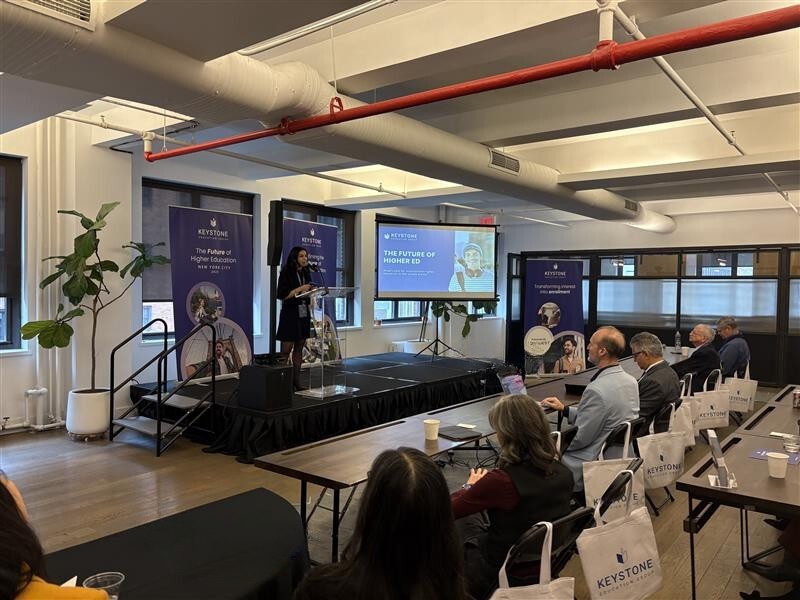- SERVICES
- HIGHER EDUCATION MARKETING
- ENGAGEMENT & ENROLLMENT MANAGEMENT
- STUDENT RECRUITMENT AGENCIES
- PROFESSIONAL EDUCATION & TRAINING
- WHO WE ARE
WHO WE ARE
Learn more about Keystone Education Group, including our leadership structure, why choose Keystone as your educational partner, and company press releases.
QUICK LINKS
- RESOURCES
RESOURCES
Find a range of helpful resources to help with your educational marketing. From on-demand webinars, reports & data, to customer testimonials and our downloadable media kit.
QUICK LINKS
- NEWS
- REQUEST A CALL

The Future of Higher Education: Conversation, Communication and Crystal Balls
8 min read
|- Keystone Higher Education News
- The Future of Higher Education: Conversation, Communication and Crystal Balls
Capturing some of the topics and takeaways from Keystone's Future of Higher Education event in New York City.
Last week, I was in New York City. And three different people asked me to explain why.
The first was a US customs officer. He asked me what the purpose of my visit to the USA was, which is his job. I explained I was there to discuss data and insight on global student interest, which is my job.
The second was a taxi driver, several hours and a few thousand miles later, who was also interested in why I’d flown halfway around the world to talk about the importance of international education – and actually agreed that it was rather important.
But the third? The third was Clare Overmann (CEO of the AIEA), who asked me to think again about how I articulate the value and purpose of my work. And she put the same question, simultaneously, to a room full of practitioners and professionals gathered together at Keystone’s Future of Higher Education event on Thursday 20 November 2025.
What follows is somewhere between a conference report, a set of data highlights (it’s me, right?) and some personal reflections on the day. Hopefully it also answers Clare’s question.
From conversation to "silent emergency"
Clare Overmann’s presentation was our keynote, following some opening remarks from Saba Davenport, Keystone’s CMO. She began by pointing out that international education finally has its wish: we’re front-page news.
Some of those front-pages may not be the news we wish to read, given that several of them cover policies pushing back against international education whilst others describe the results of those policies. But still, this is our moment. The conversations we have in that moment matter more and we’re going to have more opportunities to have them with more people. Whether those are a family member at thanksgiving or a member of congress in the elevator (sadly, Clare didn’t include examples for customs officials or taxi drivers).
What followed was an honest reflection on the need to have the right conversations with these different audiences. The evidence Clare marshalled on behalf of international education was as impressive as you’d expect from someone in her position (some favourites included the fact that each international student in the USA generates three jobs, whilst the entire budget for Fulbright is less than the cost of 4 fighter jets – I did say I’d include data highlights). But the articulation of different approaches to those facts and the need to frame them appropriately for different audiences was even more impressive and, I think, impactful.
After all, the facts have always been there, but the attention hasn’t.
Clare’s session was followed by Anna Esaki-Smith (author of Make College Your Superpower) on the demographic shifts powering international education’s ‘silent emergency’.
Put simply, countries across the developed world, including Japan, South Korea, Germany and the USA are facing falling populations, with drops concentrated among younger people of work – and university – age.
Anna’s explanation of the data was a thorough, compelling and somewhat sobering explanation of the data behind this problem and the solutions taken by countries in this situation.
And one of those solutions is to grow the number of international student enrolments and foreign-born workers (acknowledging that the one group is often willing to become a productive part of the other).
It’s for this reason that the ‘poles’ of international education are shifting – something we’ve seen repeatedly in our data – and the conversations around international education in countries like Japan and South Korea are very different to some of those Clare was preparing us for in New York.
Data trends, from search to enrolment
And then it was my turn.
Following Clare and Anna didn’t feel exactly easy – particularly not when your session starts with a headline and a far-from silent emergency of its own: the fact that, according to Keystone’s unique longitudinal trend data, international student interest in the USA is now down -47% on fall 2023.
Thankfully, I had an excellent co-presenter in Jennifer Parsons of UniQuest and Keystone Enrolment Services and our data was able to go beyond the headline to spark up a broader conversation about what’s really happening for US interest in a global context.
For example, the USA isn’t actually seeing the biggest falls across that two-year time period:
Both Canada and Australia have fallen further – by -53% and -55% respectively – and their drops in interest have been steadier and more sustained. This reminds us that the certainty of study permit caps and cost increases in these destinations can actually have a greater impact on student interest than the policy uncertainty in the USA.
Meanwhile, the story told by that UK line is one of recovery without significant policy change, driven mainly by positive rhetoric and international competition. Student interest can shift, as it has done in the past and may do again for the USA.
Indeed, as Jenni and I did our best to point out, interest in the USA remains exceptionally high despite falling in the second half of this year. As of November 2025, the following are all true:
- The USA is the most-searched destination on Keystone platforms
- It's also the first-choice alternative for students considering alternatives to the other 'Big 3'
- And the audiences considering US study are surprisingly committed, with 83% of US-bound respondents in our current Pulse survey data planning to apply as normal this year rather than deviate or defer
The real challenges facing the USA are negative push factors of policy uncertainty and the damage done to audience trust, alongside the pull factors of other countries’ national strategies paired with their growing cultural appeal to younger generations. This, I think it’s safe to say, was the first time K-Pop Demon Hunters has been referenced in a presentation on international study trends.

A juxtaposition of cultural and educational push and pull factors (K-Pop Demon Hunters copyright Netfix)
Open doors
Following a break for lunch we had the rare pleasure of Dr. Mirka Martel (Head of Research, Evaluation and Learning at the IIE) walking us through the 2025 Open Doors report in the week of its publication. The findings are available elsewhere along with plenty of excellent commentary and analysis (including some of our own).
What was most useful on the day, at least in my view, was Dr. Martel’s exploration of the nuances in the data. For example, the fact that the growth in OPT we’ve seen in 2025 (and the 2025 fall snapshot) is partly driven by expanding graduate recruitment in previous cycles, itself partly a product of the post-Covid ‘release’ in interest. Or the way in which the demographic makeup of US enrolments is shifting in different ways at different levels of study, with India now the largest source of graduate students (as it is elsewhere) but China remaining the largest source of undergraduates.
It's these kinds of connections that remind us there’s more to international study trends than ‘supply side’ policy changes; who, how and when students want to study also shapes the ‘demand side’ of the relationship. A theme that called back to Jenni and I’s data, as well as Anna’s points about demographics and Clare’s call to think about the broader conversations we need to have about int ed.

Dr. Mirka Martel overviews the findings from the 2025 Open Doors report and fall snapshot
Breakouts: SEO, communication and culture
Our track now split three ways and I chose to sit in on Brian Piper’s session on SEO, AI and the future of search. This meant I missed Dr. Jane Goodwood and Dr. Kalpen Trivedi on campus culture and sustainable partnerships, but I heard only good things. I also, yet again, missed our own Megan Prettyman on student communication strategies – about whom I always hear good things (and who I owe thanks for helping me navigate New York during the week).
Brian’s session felt just right for an audience who understood the broad importance of SEO and wanted to learn more about how AI was shaping both content creation and discovery. So, anyone with some form of responsibility for student acquisition via web traffic.
Speaking as someone who’s been ‘SEO-adjacent’ for all of my 10+ years in higher education, I made far more notes than I often do at these sessions and was impressed at just how generously Brian shared examples, tools and even specific prompts. You can take a measure of a session by how many people look to chat to the speaker afterwards and this had several.
Ending with an actual crystal ball
We ended with a panel, expertly and vibrantly chaired by Dr. Maureen Manning who – and no, I’m not kidding – did actually bring a crystal ball to the conference.

Dr. Maureen Manning and her panel take questions from the audience (crystal ball not pictured)
Sadly, we didn’t get to spend much time looking into said predictive sphere as the conversation she led with her panel, featuring Dr. Jill Blondin (Virginia Commonwealth University), Sherif Barsoum (NYU Steinhardt) and Dr. Amir Reza (Babson College) easily filled the entire session: reflecting back on the topics discussed throughout the day and setting us up for further conversation over drinks.
And my best answer to Clare’s question about how we articulate the importance of international education in different conversations? I think part of the answer is the conversation we had on the day which, for me at least, was as wide-ranging and worthwhile as its subject matter. Here's to the next one.

Dr. Mark Bennett
Dr. Mark Bennett is the VP of Research and Insights at Keystone Education Group. Leveraging Keystone's unique data and insights, Mark regularly presents on global higher education trends, recruitment, and policy topics, having previously spoken at events organized by NAFSA, CASE Universities Marketing Forum (UMF), HELOA, NAGAP, ContentEd, the UK Council for Graduate Education (UKCGE), Westminster Forum and others. Mark taught at multiple UK universities prior to joining Keystone and holds a PhD in gothic literature from the University of Sheffield.
More about:
Related Tags
Just For You
Top Picks
Higher Ed Chats Podcast
Listen to the latest episodes of our Higher Ed Chats Podcast. Hear from Higher Ed thought-leaders from around the world!
Watch on-demand:
State of Student Recruitment UK

Opportunities in a Shifting Landscape
Subscribe
to get the latest news and updates





